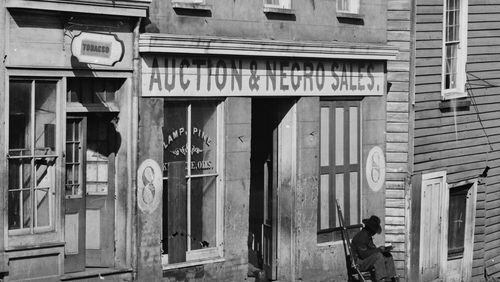There’s a fine line between taking lessons “out of the box” and going outside acceptable parameters. While administrators praise educators for finding innovative ways to make sure students are engaged and to keep curriculum fresh, they also warn them not to veer too far off script.
Teachers can face career consequences when a creative way history lessons are presented crosses some line and strikes a cultural or racial nerve.
A recent incident at Gwinnett County’s Discovery High School demonstrated this conundrum.
During a world geography lesson about the transatlantic slave trade, the teacher used a slide in a PowerPoint presentation that stated Europeans didn’t kidnap Africans and sell them as slaves; other Africans sold the slaves to colonialists. A parent raised concerns that the information was incorrect at least and incendiary at worst. She said she wasn’t angry, just wants her daughter and her classmates taught accurate history. “It’s very important that our kids are aware of where we come from,” she was quoted as saying.
In investigating the incident, school district officials found that the teacher and perhaps one other used materials other than those provided by the school system.
“The lesson the teacher presented to students covered how colonialists partitioned Africa, but the slide he used is not a part of the district-wide geography curriculum,” said Sloan Roach, a Gwinnett County schools spokeswoman. “As was explained to the parent, the slide was not meant to be an exhaustive or in-depth look at the enslavement of Africans, a topic which is covered more thoroughly in World History.”
A search of AJC archives shows that just about every year for the past decade or so there’s been a well-intentioned lesson gone awry.
- Last year a Cobb County parent complained that an annual event where children are encouraged to dress in "period attire" for Civil War Day made light of a serious subject. The mother said a friend told her son, " 'We had to dress up so I'm a plantation owner and you're my slave.' "
- Also in 2017, a Gwinnett County teacher came under fire for a homework assignment where sixth-graders were asked to draw a Nazi mascot.
- In 2016, a popular Cobb County teacher made international headlines when a grandmother complained on social media that a teacher-created simulation of the Underground Railroad went too far. Some of the barrage of criticism of the school and the teacher was based on erroneous information that the girl was the only black student in the class and was somehow singled out to remain on the plantation rather than forge her way to freedom.
Georgia standards require that fifth-graders learn about how states’ rights and slavery fueled the growing tensions between the North and South. “It is very hard to bring that down to a 10-year-old’s level,” that teacher, Hope Largent, a Georgia Southern graduate who was in her second year at Cheatham Hill Elementary School, told The AJC at the time. “I wanted to find something interactive, engaging and memorable.”
In 2012, a Gwinnett elementary teacher resigned after giving slavery-themed math questions including, “If Frederick got two beatings per day, how many beatings did he get in one week?” School officials said the questions were meant to link a history lesson about Frederick Douglass to math computation.
Jonathan Patterson, associate superintendent for curriculum and instructional support at Gwinnett County Public Schools, explained that the district tries to avoid these types of occurrences with structured courses, training, mentorship and peer support.
“Scripting lessons for 6,000 courses for the 180 days of school is a tough undertaking,” he said. “We have a process that involves a lot of systems.”
Gwinnett's system, called Academic Knowledge and Skills Curriculum, is based on Georgia Performance Standards and developed by teachers with input from parents and the community. That curriculum goes through an oversight committee called Gwinnett Educational Management System, which is also composed of school district employees and others. The lessons then go through another review process before they are adopted.
Once the curriculum is in place, teachers have weekly meetings with peers and a curriculum director to design lessons around the standards and discuss innovative ways to reach students.
“Most lessons are scripted to a certain degree and have suggested supplemental materials,” said Patterson.
But he was quick to point out that the best and brightest teachers and often those with the most experience find their own style and develop their own best practices.
When a situation like the one at Discovery High surfaces, the district looks at additional training and reassesses if teachers have adequate tools to do their jobs.
“The goal is to provide resources that stick tightly to the AKS standards, but creativity is an important part of being a good teacher,” said Patterson.
When it comes to sensitive subjects — especially those that deal with race or sex — it’s best for teachers to seek materials from trusted sources, said Stan Deaton, senior historian for the Georgia Historical Society.
His organization provides seminars to help teachers become more aware of the nuances of slavery, especially in the South where so many reminders of that period still exist.
“There are groups that want to further a certain agenda and they may present information out of context under the guise of education,” said Deaton. “That’s why you can’t go with just anything you find on the Internet or through social media.”
Even those that mean well may not understand the deeper, broader implications of transatlantic slave trade, African colonialism, tribal warfare, etc., he added. Although one unit about African exports doesn’t afford the time for in-depth discussions about those subjects, it helps if the instructor has the knowledge to put questions into perspective.
The Georgia Historical Society and the New Georgia Encyclopedia offer a myriad of educational materials as well as staff to help teachers wade through some of the more complicated issues.
Former teacher Donna McBride agreed on the need for reliable sources of information.
As a Henry County School Board member and a former special education teacher for all grades, she said sometimes educators don’t want let on that they don’t know something.
“For a lot of people teaching is not their first profession and they may lack some of the training that comes from a education background. And new teachers don’t always know all the resources where they can get trusted material,” she said.
About the Author







